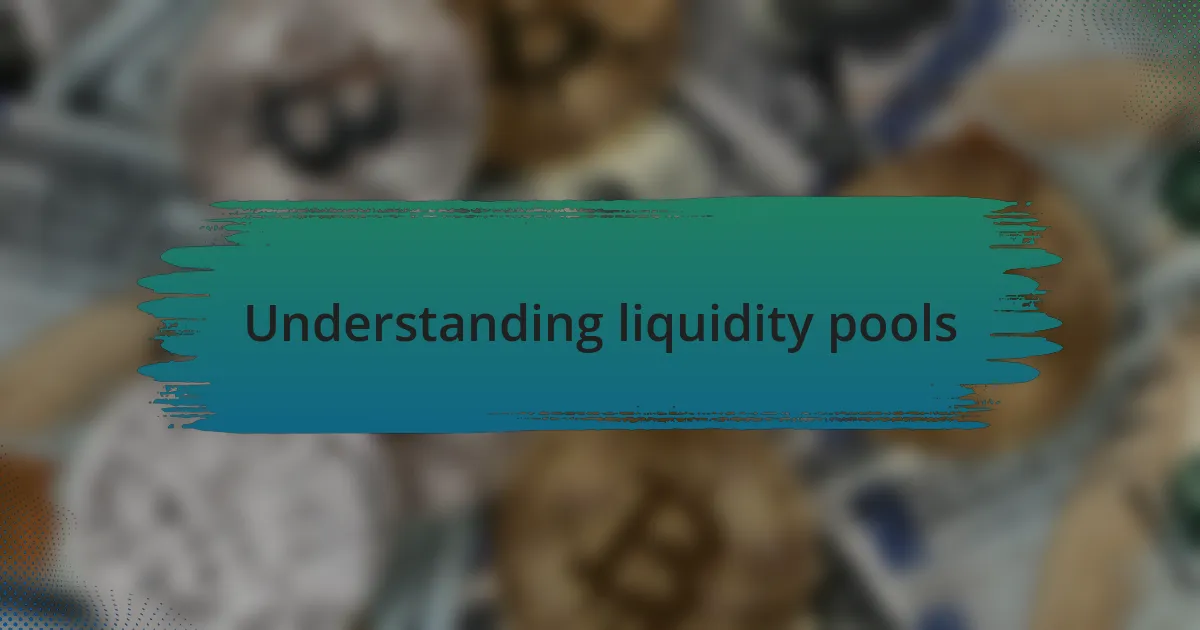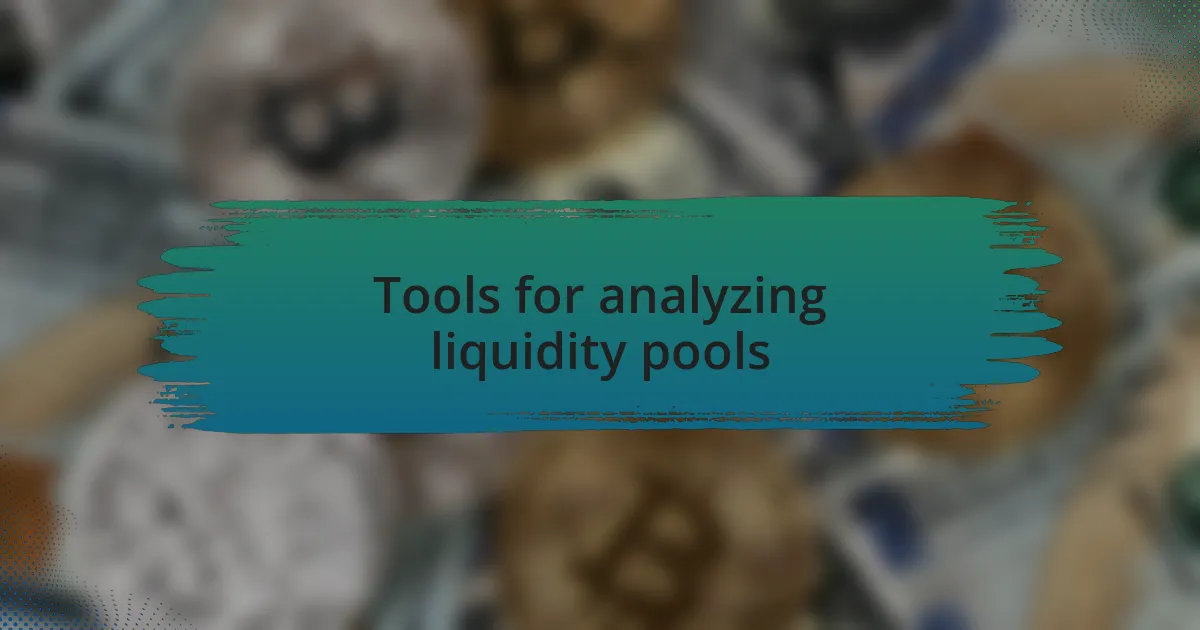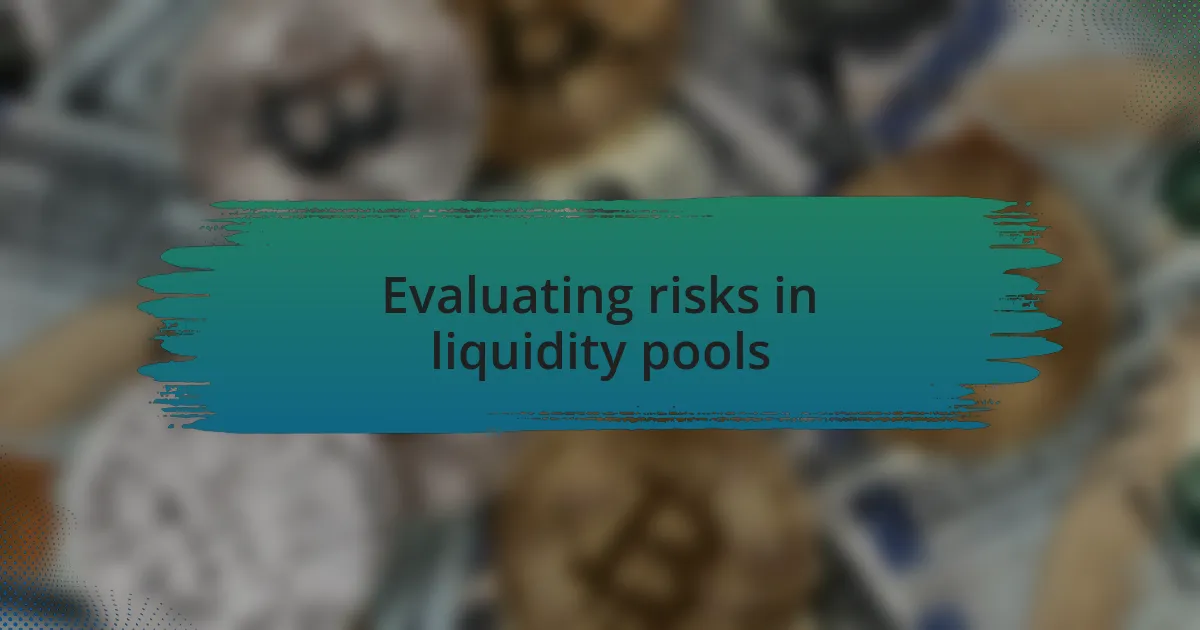Key takeaways:
- Liquidity pools enhance market efficiency, reduce slippage risks, and allow individuals to earn transaction fees by contributing assets.
- High liquidity is crucial for smooth transactions, market confidence, and broader investor participation, while low liquidity can indicate volatility and risks.
- Key metrics for evaluating liquidity pools include Total Value Locked (TVL), liquidity depth, and trading volume, which help inform investment decisions.
- Risk evaluation is essential, focusing on impermanent loss, smart contract security, and liquidity depth to ensure robust investment strategies.

Understanding liquidity pools
Liquidity pools are essentially collections of funds locked in smart contracts that facilitate trading on decentralized exchanges. When I first started exploring this space, I was fascinated by how these pools increase market efficiency and reduce the risk of slippage, a term that describes price changes when buying or selling large amounts.
I remember my early days in crypto, feeling overwhelmed by the intricacies of liquidity. I often wondered, why would anyone want to contribute their assets to a pool rather than just holding them? The answer lies in the potential for yield. By adding liquidity, individuals can earn transaction fees and incentives, making their assets work for them rather than sitting idle.
Understanding the mechanics of liquidity pools can initially seem daunting, but once I dug deeper, it became clear that they play a critical role in the decentralized finance (DeFi) ecosystem. Have you ever tried to gauge how quickly you can trade an asset without impacting its price? That’s exactly what liquidity pools help with—they create a smoother trading experience for everyone involved.

Importance of liquidity in cryptocurrency
Liquidity is vital in the cryptocurrency space because it directly impacts the ease of buying and selling assets. I think back to a time when I tried to purchase a lesser-known token on a decentralized exchange. The lack of liquidity made the process frustrating, causing significant price swings with each small purchase I made. That experience taught me that high liquidity allows for smoother transactions and ensures that traders can enter and exit positions without severely affecting the price.
Additionally, liquidity serves as a measure of market confidence. When I observe a well-funded liquidity pool, it reassures me about the asset’s stability and long-term viability. Conversely, a pool with low liquidity can signify trouble, often leading to higher volatility and risks. When you think about your investment strategy, wouldn’t you prefer assets that allow for more predictable transactions?
Moreover, I’ve learned that liquidity fosters broader market participation. When liquidity is abundant, it attracts a diverse group of investors, enhancing the overall trading environment. I remember feeling a sense of camaraderie while trading within high liquidity spaces, where each transaction felt less like a gamble and more like a collective effort to engage in the market. Does that sense of community and stability resonate with you? It certainly makes a difference in how I approach my investments.

Key metrics for pool performance
To effectively analyze liquidity pool performance, several key metrics stand out. One crucial metric is the Total Value Locked (TVL), which represents the total capital held within a liquidity pool. I recall the first time I examined the TVL of a promising project; it was eye-opening to see how much capital was committed and how that signaled not only market interest but also potential stability.
Another important aspect is the pool’s liquidity depth, which indicates how much capital is available at various price levels. I’ve often found myself in situations where a shallow liquidity depth meant I could only make small trades without causing significant price fluctuations. This has reinforced my understanding that deeper pools tend to be more resilient against volatility—doesn’t that kind of stability sound appealing for your trading strategy?
Moreover, the trading volume associated with a liquidity pool is a vital indicator of its activity and attractiveness. When I notice consistent trading volume, it gives me confidence that there’s interest and demand for the assets in that pool. It’s a bit like attending a bustling market rather than an empty stall; would you prefer to trade where there’s clearly a vibrant exchange happening? For me, active pools often translate to increased opportunities and a richer trading experience.

Tools for analyzing liquidity pools
When diving into the analysis of liquidity pools, several tools can revolutionize your approach. One of my go-to resources is Dune Analytics, which provides customizable dashboards to visualize real-time data. The first time I set up a dashboard to track multiple pools, I was amazed at how easily I could see trends emerge that would have otherwise gone unnoticed. Does tracking your investments in such detail empower you? It certainly did for me.
Another invaluable tool is Token Terminal, which allows you to assess the financial metrics of liquidity pools with a focus on yield and profitability. Analyzing historical data on yield performance helped me make more informed decisions about where to allocate my funds. I vividly recall a moment when I switched my investments based on the insights I gained; it not only improved my returns but also deepened my understanding of market dynamics.
Lastly, exploring community-driven platforms like Yieldwatch can provide a rich layer of insights. I remember feeling part of something bigger when I accessed peer analysis and pooled recommendations. Engaging with these vibrant communities adds a social element to data analysis, making the journey of tracking liquidity pools feel less solitary. What about you? Do you find community insights enhance your own trading experience in the crypto sphere?

Personal strategies for effective analysis
When I analyze liquidity pools, I often dive into on-chain metrics to evaluate performance. For me, studying transaction volumes helps identify patterns in liquidity flow. I remember the thrill of noticing a spike in volume for a specific pool, which prompted me to adjust my strategy immediately. Have you ever felt that rush when spotting a trend before others?
Another tactic I find effective is setting clear benchmarks for comparison. By measuring the performance of a pool against similar ones, I can determine if I’m making a wise investment. I’ve had experiences where I initially overlooked a pool, only to realize later it outperformed others with similar risk profiles. This taught me the value of always keeping an open eye on multiple options – isn’t it fascinating how one small change can drastically alter your investment journey?
Finally, I like to combine qualitative analysis with quantitative data. Reading community sentiments on social media or engaging in forums adds context to the numbers I see. Once, I hesitated to invest in a promising liquidity pool until I discovered discussions highlighting potential red flags. It was a moment of relief that reinforced my belief in a comprehensive analysis approach. How do you balance numbers with community insights when assessing your investments?

Evaluating risks in liquidity pools
Evaluating risks in liquidity pools involves understanding the potential for impermanent loss. I’ll never forget the time I faced significant losses when a pool I trusted experienced severe fluctuations. It was a tough lesson that highlighted how rapidly market conditions can change and why I always consider the volatility of the assets in a pool before diving in. Have you ever felt that unsettling moment when your investment takes a turn for the worst?
Another risk to keep in mind is smart contract exposure. Once, I was intrigued by a liquidity pool with impressive returns, but then I stumbled upon a vulnerability report. It made me rethink my position entirely, knowing that the technology behind a pool could be as risky as the assets themselves. How do you ensure the projects you support aren’t just promising but also secure?
Additionally, I pay close attention to the liquidity depth of a pool. One time, I almost invested in a shallow pool before realizing that low liquidity can lead to significant slippage. It’s essential to ask yourself: is this pool robust enough to withstand market movements without adversely affecting your transactions? Those moments have taught me the importance of vigilance in both research and execution.

Case studies of successful analysis
When I reflect on my analysis of liquidity pools, one standout case was a DEX that boasted attractive yields. I meticulously tracked its performance over six months, and what amazed me was the correlation between the pool’s depth and the yields offered. I discovered that during market dips, this pool maintained surprisingly stable returns. It left me wondering: how often do we overlook the steady rocks in favor of the flashy newcomers?
Another instance that shaped my approach involved a project that initially seemed promising but had fluctuating returns. After digging deeper, I realized their tokenomics were poorly structured. This experience reinforced my belief that understanding a project’s underlying mechanics is just as crucial as monitoring its performance. I couldn’t help but think about how many investors base their decisions on looks alone, without peeling back the layers.
Lastly, I analyzed a pool during a market surge, while comparing notes with peers. We noticed that pools with diversified assets performed better than those concentrating on a single coin. This conversation sparked a realization: perhaps diversity is not just an investment strategy; it might be the very lifeblood of sustainable liquidity. Have you ever experienced a moment where insights from others changed your perspective entirely?